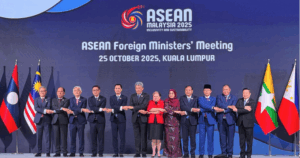KUALA LUMPUR — Leaders from across the globe have converged on the Malaysian capital ahead of the opening of the 47th Association of Southeast Asian Nations (ASEAN) Summit and its related meetings, officially beginning Sunday at the Kuala Lumpur Convention Centre and running through October 28. Domestically, Malaysia is showcasing its role as host and regional convenor; internationally, the Summit underscores ASEAN’s expanding diplomatic reach.
Malaysia at the Centre
Serving as this year’s ASEAN Chair, Malaysia is welcoming over 30 heads of state and government including from the United States, China, Japan, South Korea, Brazil, Australia, New Zealand and South Africa. One of the more prominent visitors is António Costa, President of the European Council, attending as Guest of the Chair—a first for the European Union at an ASEAN Summit, signalling deepening Europe-Asia ties.
The official theme of the gathering is “Inclusivity and Sustainability”, reflecting ASEAN’s ambition to broaden participation and align regional cooperation with global challenges such as climate change, economic realignment and connectivity.
Key Agenda Items
Among the major items on the agenda:
- A ceremonial hand-over of ASEAN chairmanship from Malaysia to the Philippines, with Ferdinand “Bongbong” Marcos Jr. present to witness the transfer.
- The signing of the Declaration on the Admission of Timor‑Leste as the 11th ASEAN member, a landmark expansion that underlines ASEAN’s evolving integration.
- High-level participation from inter-governmental bodies including the United Nations, the International Monetary Fund, the World Bank and the International Federation of Association Football (FIFA), highlighting the summit’s widening remit beyond traditional diplomacy.
Strategic Goals and Regional Significance
The summit’s major goals include:
- Strengthening regional cooperation in economics, trade, connectivity and digital adoption, particularly as global trade patterns shift and supply chains adapt.
- Reinforcing ASEAN’s role as a convenor of global players, allowing Southeast Asia to assert greater strategic relevance amid US-China competition and broader global realignment.
- Cementing institutional renewal through enlargement (via Timor-Leste) and by welcoming new partnerships (e.g., EU engagement) to enhance the bloc’s geopolitical and economic footprint.
- Addressing regional security, inclusive growth and sustainability challenges such as climate resilience, green infrastructure and equitable development.
The Thai-Cambodian Border Conflict: A Moment of Reckoning
A particularly high-stakes agenda item is the border conflict between Thailand and Cambodia, which has long simmered and resurfaced violently in 2025. The contested territory around the Preah Vihear temple and adjoining hill zones has triggered artillery exchanges, troop deployments and the displacement of hundreds of thousands of civilians.
Reports indicate that a formal peace deal is to be signed on the sidelines of the Summit, timed with the arrival of Donald J. Trump, who will preside over what many are calling a major diplomatic spectacle. While a cease-fire effective in late July temporarily halted the worst of the fighting, observers caution that the underlying territorial, historical and political grievances remain fragile.
Thailand and Cambodia have committed to the peace deal partly to restore regional stability and to demonstrate ASEAN’s relevance in conflict resolution. Yet analysts emphasise that monitoring mechanisms, trust-building and deeper diplomacy will be required for the truce to hold.
What to Watch
Over the course of the Summit, attention will focus on:
- The text of the Timor-Leste admission declaration: Does it include concrete timelines or membership commitments?
- Trade and economic declarations: Will ASEAN announce new frameworks or joint statements with global partners like the EU, US or China?
- The outcome of bilateral meetings on the sidelines, especially US-China trade talks and regional security pacts.
- Follow-through on the Thai-Cambodia peace signing: Will it generate operational measures (de-mining, joint border patrols, displaced-persons return) or will it remain largely symbolic?
- Malaysia’s ability, as host, to leverage the summit into tangible regional momentum, particularly on sustainability and connectivity fronts.
As the leaders take their seats in Kuala Lumpur, the 47th ASEAN Summit arrives at a time when Southeast Asia is not only navigating its internal ambitions but also the wider architecture of global cooperation and contestation. The hand-over of the chair and the expected border peace deal add extra urgency and symbolism—raising questions not just of ceremony but of substance. (zai)

